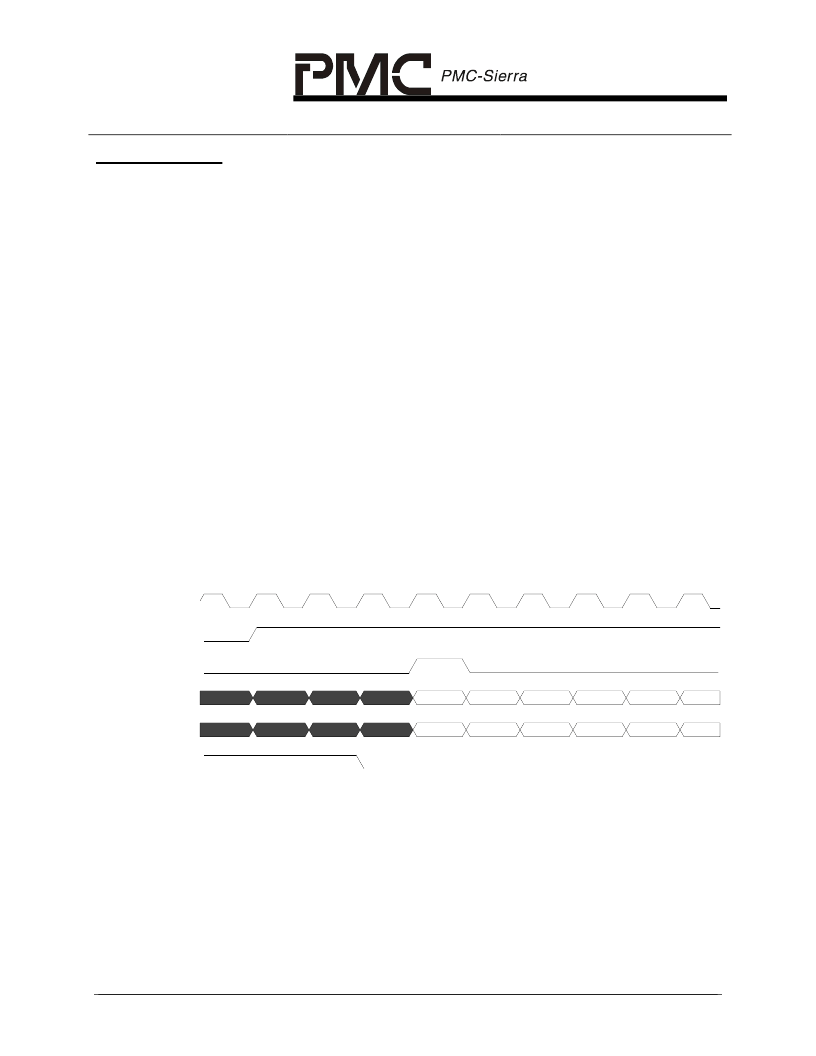- 您現(xiàn)在的位置:買賣IC網(wǎng) > PDF目錄378055 > PM73122-BI (PMC-SIERRA INC) 32 LINK CES/DBCES AAL1 SAR PROCESSOR PDF資料下載
參數(shù)資料
| 型號: | PM73122-BI |
| 廠商: | PMC-SIERRA INC |
| 元件分類: | 數(shù)字傳輸電路 |
| 英文描述: | 32 LINK CES/DBCES AAL1 SAR PROCESSOR |
| 中文描述: | ATM SEGMENTATION AND REASSEMBLY DEVICE, PBGA352 |
| 封裝: | 35 X 35 MM, 1.51 MM HEIGHT, SBGA-352 |
| 文件頁數(shù): | 432/489頁 |
| 文件大?。?/td> | 4416K |
| 代理商: | PM73122-BI |
第1頁第2頁第3頁第4頁第5頁第6頁第7頁第8頁第9頁第10頁第11頁第12頁第13頁第14頁第15頁第16頁第17頁第18頁第19頁第20頁第21頁第22頁第23頁第24頁第25頁第26頁第27頁第28頁第29頁第30頁第31頁第32頁第33頁第34頁第35頁第36頁第37頁第38頁第39頁第40頁第41頁第42頁第43頁第44頁第45頁第46頁第47頁第48頁第49頁第50頁第51頁第52頁第53頁第54頁第55頁第56頁第57頁第58頁第59頁第60頁第61頁第62頁第63頁第64頁第65頁第66頁第67頁第68頁第69頁第70頁第71頁第72頁第73頁第74頁第75頁第76頁第77頁第78頁第79頁第80頁第81頁第82頁第83頁第84頁第85頁第86頁第87頁第88頁第89頁第90頁第91頁第92頁第93頁第94頁第95頁第96頁第97頁第98頁第99頁第100頁第101頁第102頁第103頁第104頁第105頁第106頁第107頁第108頁第109頁第110頁第111頁第112頁第113頁第114頁第115頁第116頁第117頁第118頁第119頁第120頁第121頁第122頁第123頁第124頁第125頁第126頁第127頁第128頁第129頁第130頁第131頁第132頁第133頁第134頁第135頁第136頁第137頁第138頁第139頁第140頁第141頁第142頁第143頁第144頁第145頁第146頁第147頁第148頁第149頁第150頁第151頁第152頁第153頁第154頁第155頁第156頁第157頁第158頁第159頁第160頁第161頁第162頁第163頁第164頁第165頁第166頁第167頁第168頁第169頁第170頁第171頁第172頁第173頁第174頁第175頁第176頁第177頁第178頁第179頁第180頁第181頁第182頁第183頁第184頁第185頁第186頁第187頁第188頁第189頁第190頁第191頁第192頁第193頁第194頁第195頁第196頁第197頁第198頁第199頁第200頁第201頁第202頁第203頁第204頁第205頁第206頁第207頁第208頁第209頁第210頁第211頁第212頁第213頁第214頁第215頁第216頁第217頁第218頁第219頁第220頁第221頁第222頁第223頁第224頁第225頁第226頁第227頁第228頁第229頁第230頁第231頁第232頁第233頁第234頁第235頁第236頁第237頁第238頁第239頁第240頁第241頁第242頁第243頁第244頁第245頁第246頁第247頁第248頁第249頁第250頁第251頁第252頁第253頁第254頁第255頁第256頁第257頁第258頁第259頁第260頁第261頁第262頁第263頁第264頁第265頁第266頁第267頁第268頁第269頁第270頁第271頁第272頁第273頁第274頁第275頁第276頁第277頁第278頁第279頁第280頁第281頁第282頁第283頁第284頁第285頁第286頁第287頁第288頁第289頁第290頁第291頁第292頁第293頁第294頁第295頁第296頁第297頁第298頁第299頁第300頁第301頁第302頁第303頁第304頁第305頁第306頁第307頁第308頁第309頁第310頁第311頁第312頁第313頁第314頁第315頁第316頁第317頁第318頁第319頁第320頁第321頁第322頁第323頁第324頁第325頁第326頁第327頁第328頁第329頁第330頁第331頁第332頁第333頁第334頁第335頁第336頁第337頁第338頁第339頁第340頁第341頁第342頁第343頁第344頁第345頁第346頁第347頁第348頁第349頁第350頁第351頁第352頁第353頁第354頁第355頁第356頁第357頁第358頁第359頁第360頁第361頁第362頁第363頁第364頁第365頁第366頁第367頁第368頁第369頁第370頁第371頁第372頁第373頁第374頁第375頁第376頁第377頁第378頁第379頁第380頁第381頁第382頁第383頁第384頁第385頁第386頁第387頁第388頁第389頁第390頁第391頁第392頁第393頁第394頁第395頁第396頁第397頁第398頁第399頁第400頁第401頁第402頁第403頁第404頁第405頁第406頁第407頁第408頁第409頁第410頁第411頁第412頁第413頁第414頁第415頁第416頁第417頁第418頁第419頁第420頁第421頁第422頁第423頁第424頁第425頁第426頁第427頁第428頁第429頁第430頁第431頁當(dāng)前第432頁第433頁第434頁第435頁第436頁第437頁第438頁第439頁第440頁第441頁第442頁第443頁第444頁第445頁第446頁第447頁第448頁第449頁第450頁第451頁第452頁第453頁第454頁第455頁第456頁第457頁第458頁第459頁第460頁第461頁第462頁第463頁第464頁第465頁第466頁第467頁第468頁第469頁第470頁第471頁第472頁第473頁第474頁第475頁第476頁第477頁第478頁第479頁第480頁第481頁第482頁第483頁第484頁第485頁第486頁第487頁第488頁第489頁

RELEASED
PM73122 AAL1GATOR-32
DATASHEET
PMC-1981419
ISSUE 7
32 LINK CES/DBCES AAL1 SAR PROCESSOR
PROPRIETARY AND CONFIDENTIAL TO PMC-SIERRA, INC., AND FOR ITS CUSTOMERS’ INTERNAL USE
407
15.2 Sink Utopia
In ATM master mode, the SNK_INTF block receives RATM_DATA, RATM_PAR,
RATM_SOC, and RATM_CLAV while driving RATM_ENB. During reset the
SNK_INTF tristates the RATM_ENB (and all other SRC_INTF outputs). After the
end of reset and after UI_EN in the UI_COMN_CFG register is set, if the
RATM_CLAV input signal is not asserted the SNK_INTF waits and RATM_ENB
is deasserted high. As shown in Figure 101, once the RATM_CLAV input signal
is asserted, the RATM_RENB output signal is asserted low 2 cycles later and it is
expected that the PHY slave will deliver the first data byte one cycle after RENB
goes low. Typically a start-of-cell signal will be sent by the PHY slave along with
the first byte of data, however RATM_SOC is optional and the RATM_SOC input
could be tied low. Note however, not using an SOC eliminates the possibility of
runt cell detection. Once RATM_ENB goes low, a counter is started, and 53
bytes are expected. If an SOC occurs within a cell, the counter reinitializes and
the previous corrupted cell will be dropped and the second good cell will be
received. The SNK_INTF block stores the ATM cell in the receive FIFO. The 4
cell MCFF FIFO allows the interface to accept data at the maximum rate and if
the FIFO fills, the RATM_ENB signal will not be asserted again until
RATM_CLAV is asserted and the device is ready to accept an entire cell. The
maximum supported clock rate is 52 MHz.
Figure 101 SNK_INTF Start-of-Transfer Timing (Utopia 1 ATM Mode)
D1
D2
D3
D4
D5
D6
P1
P2
P3
P4
P5
P6
RATM_CLK(i)
RATM_CLAV(i)
RATM_SOC(i)
RATM_DATA(i)
RATM_PRTY(i)
RATM_ENB(o)
Note that in ATM master mode the SNK_INTF uses cell based handshaking, thus
once a transfer has begun, RATM_ENB will be asserted continuously until the
end of the cell regardless of the state of RATM_CLAV. Figure 102 shows the
end of transfer signal behavior. In this example, since the PHY slave does not
have another cell to deliver, the RATM_CLAV signal is deasserted after the last
byte is delivered. Also, the AAL1GATOR acting as an ATM master always
deasserts the RATM_ENB at the end of a cell transfer. RATM_CLAV is then
sampled again on the following clock cycle, and if asserted, RATM_ENB will be
asserted again for a new transfer.
相關(guān)PDF資料 |
PDF描述 |
|---|---|
| PM73123 | 8 LINK CES/DBCES AAL1 SAR |
| PM73123-PI | 8 LINK CES/DBCES AAL1 SAR |
| PM73124 | 4 Link CES/DBCES AAL1 SAR |
| PM7323 | ROUTING CONTROL, MONITORING, & POLICING 200 MBPS |
| PM7323-SI | ROUTING CONTROL, MONITORING, & POLICING 200 MBPS |
相關(guān)代理商/技術(shù)參數(shù) |
參數(shù)描述 |
|---|---|
| PM73122-BIP | 制造商:PMC-Sierra 功能描述:AAL1GATOR32 EOL270906 |
| PM73122-BI-P | 制造商:PMC-Sierra 功能描述: |
| PM73123 | 制造商:PMC 制造商全稱:PMC 功能描述:8 Link CES/DBCES AAL1 SAR |
| PM73123PI | 制造商:PMC-Sierra 功能描述: |
| PM73123-PI | 制造商:PMC 制造商全稱:PMC 功能描述:8 LINK CES/DBCES AAL1 SAR |
發(fā)布緊急采購,3分鐘左右您將得到回復(fù)。